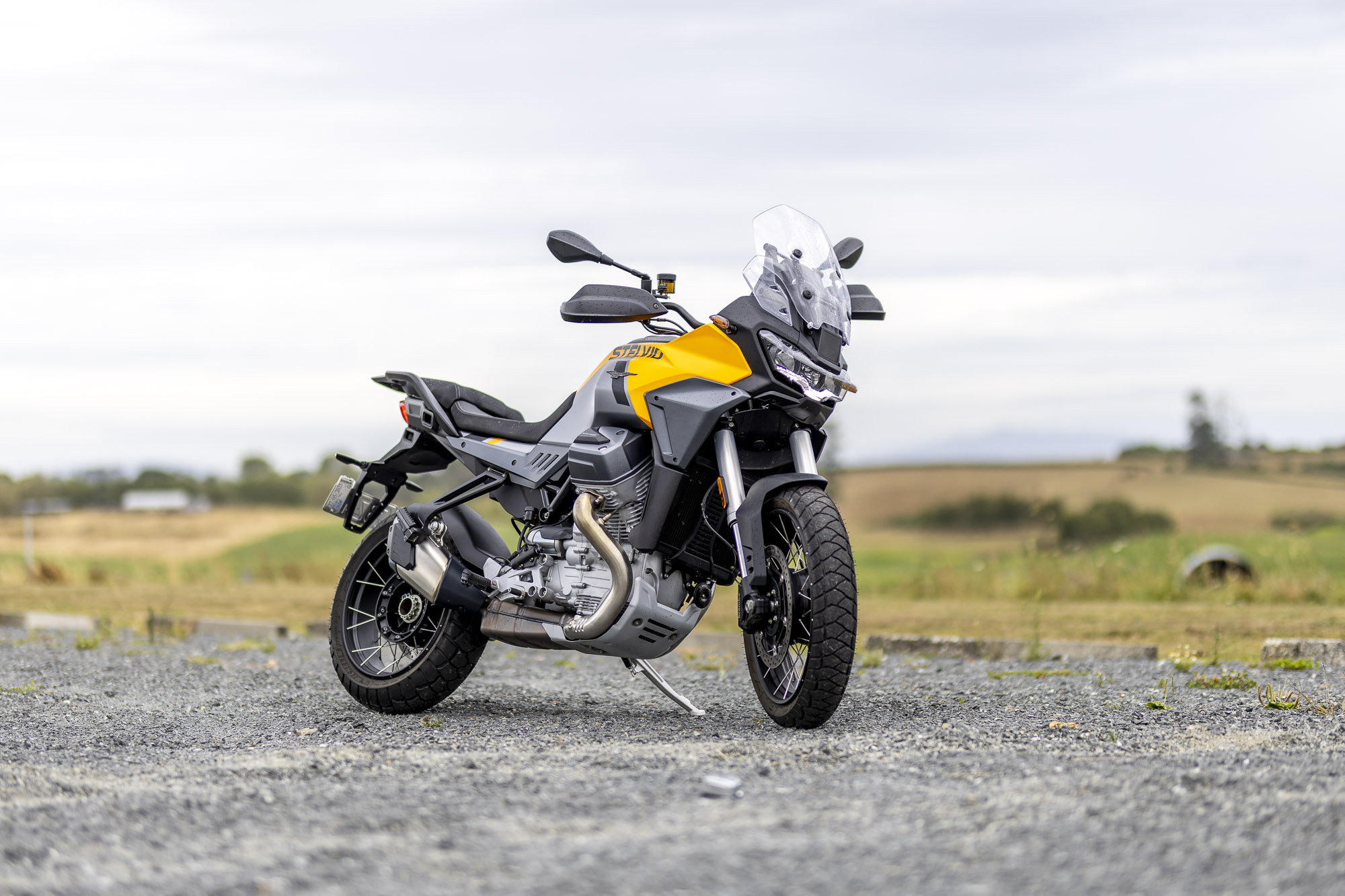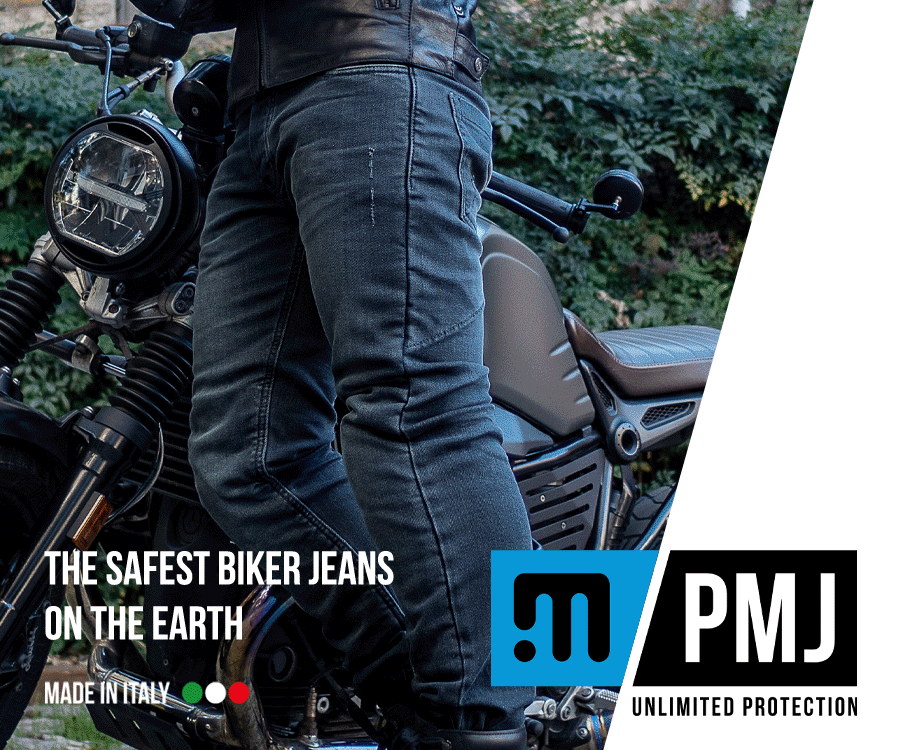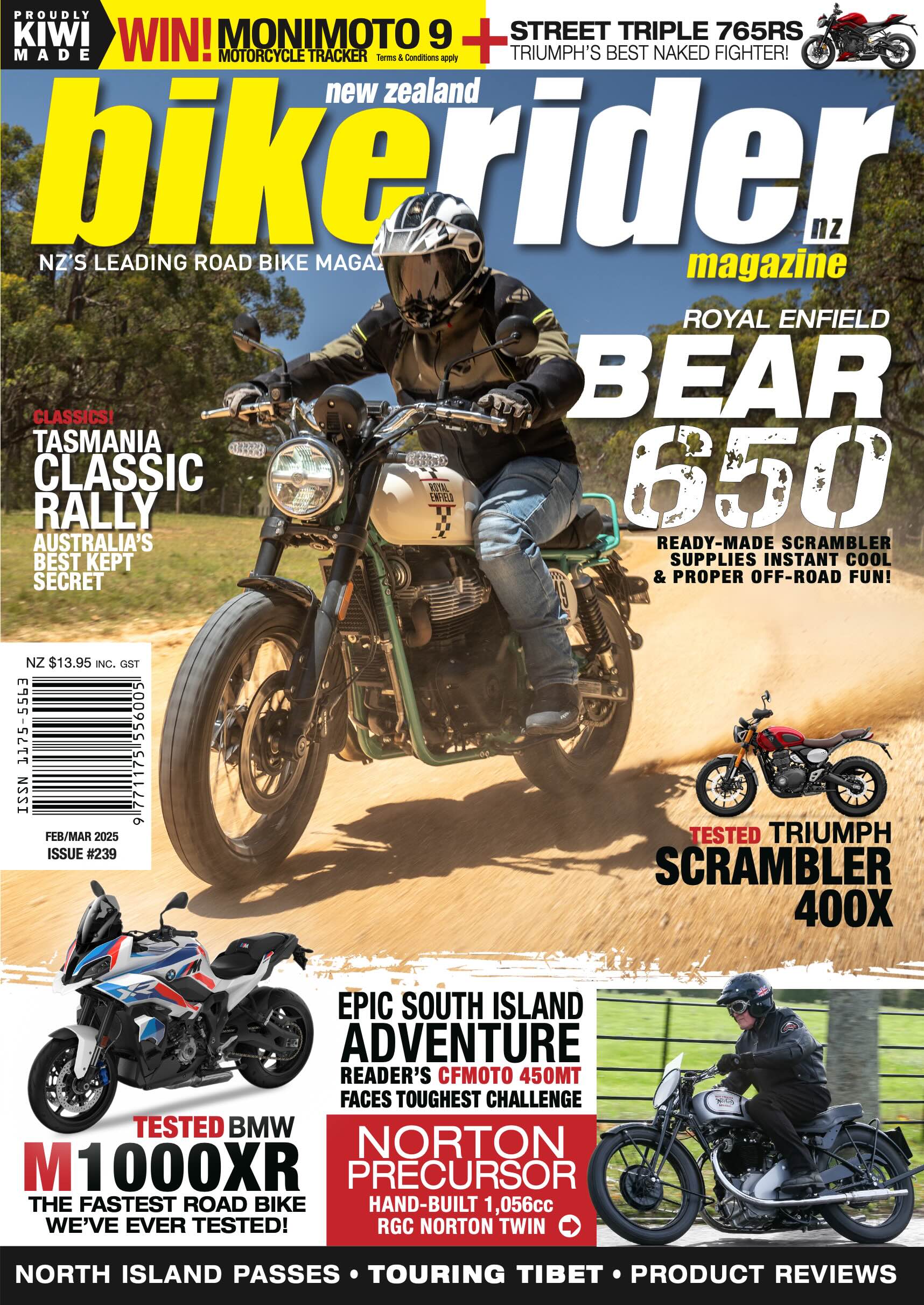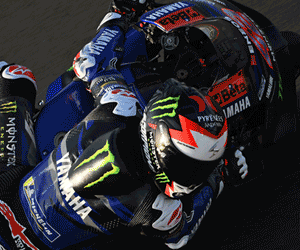- Second model to get Moto Guzzi’s new ‘compact block’ powerplant.
- Comprehensive electronics including off-road settings.
- 19-inch front wheel makes it an ‘adventure tourer’.
As the second model to be powered by Moto Guzzi’s new ‘Compact Block’ powerplant, we didn’t think it could get any better than the thoroughly enjoyable V100 Mandello. But it seems that the transverse V-twin shines no matter what segment the Italian marque slots it into.
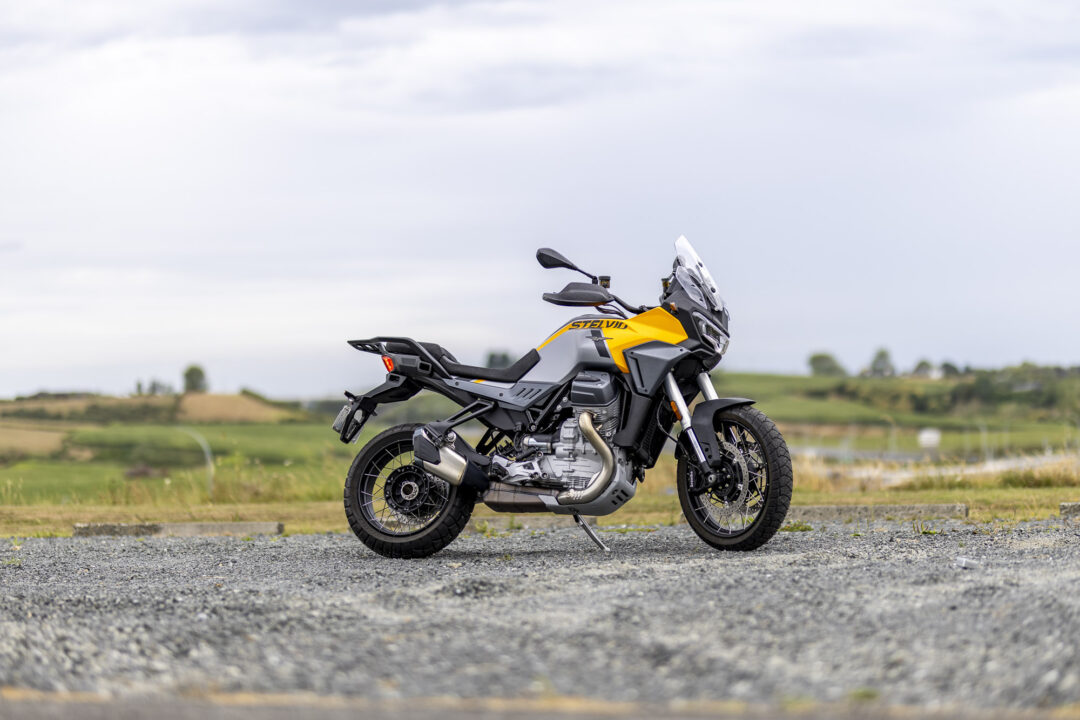
We had a review of the new Moto Guzzi adventure tourer in Bike Rider Magazine early in 2024 after contributor Alan Cathcart got an exclusive invite to test the new model in Italy ahead of its world launch. Well, almost 12 months later, we finally got our chance to swing a leg over the – surprisingly low – saddle of the Stelvio and discovered you don’t need massive horsepower to have fun when the motor is this good.
Moto Guzzi has traditionally been a small volume builder of, shall we say, ‘interesting’ motorcycles, with the quirks inherent from their transverse V-twin and shaft-drive set-ups making them appeal to a select group of riders while shying away from targeting the masses. But that is changing with the advent of the new ‘Compact Block’ powerplant which was developed under the umbrella of Moto Guzzi’s owners, the Piaggio Group, and has addressed the factors that made Guzzis unique yet ultimately hindered their sales success. The change has been a long time coming since Piaggio bought Guzzi in 2004, with the group’s other brand, Aprilia, seemingly first in the queue for attention before they turned their sights to the more niche manufacturer.
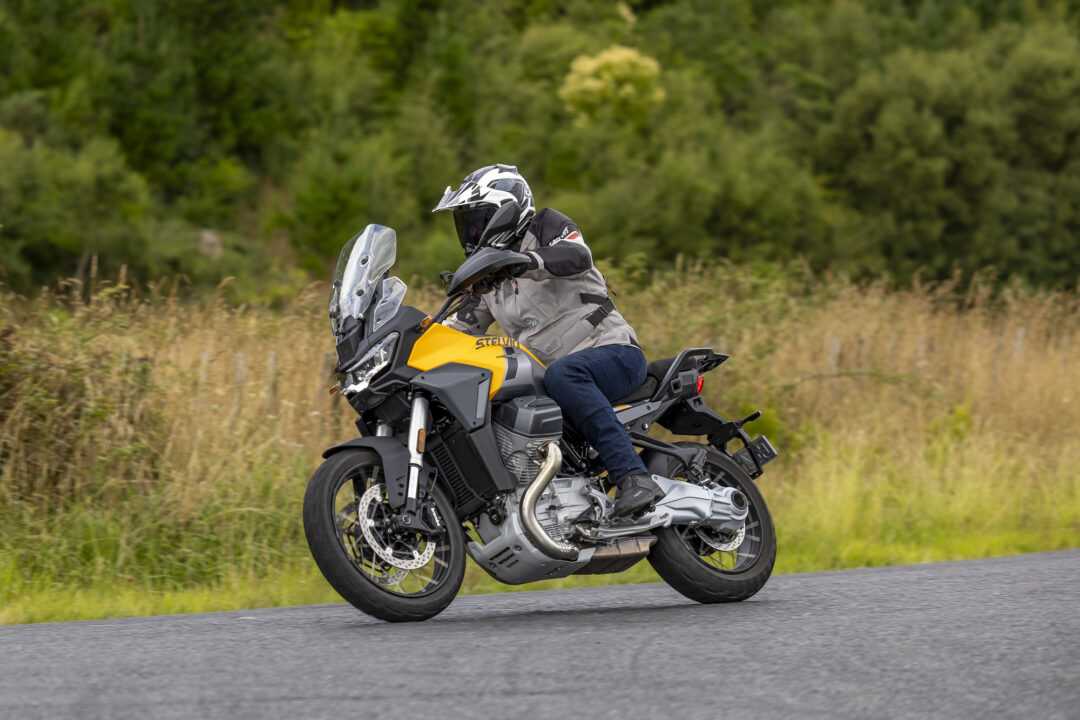
What Is It?
The Stelvio is essentially a road bike that’s dressed up to look like an adventure machine. Taking its name from the highest mountain pass in Italy (the Stelvio Pass), which is all tar-sealed, sort of gives the game away, as does the fact the front wheel is a more road-biased 19-inch in size, and the bike has a wet weight of 246 kilos. But that’s okay, as most motorcyclists (especially those of a certain age…) have worked out that the sit-up riding position and softer, more compliant long-travel suspension of an adventure-styled bike makes it much more comfortable for clocking off long distances. And while they don’t have the lightning reflexes of sportier machines, advances in tyre technology, suspension and electronics have seen these giants of the road become exceptionally capable of showing a decent turn of speed in the right hands.
And the Stelvio ticks all the boxes for a bike in this adventure touring category. The electronically adjustable screen does an excellent job of offering undisturbed airflow when set at the lower setting, while sitting the rider in a protective bubble of calmness when set at the highest. The seat height is surprisingly low considering the style of bike, making the weight and size of the machine much more manageable due to the lower centre of gravity, while the pegs are still a decent distance from your butt, meaning there was never a point where I felt my legs were cramped. And while the handlebars are set relatively high for when you decide to get into the adventurer’s stand-up stance, they aren’t uncomfortable. It’s a pretty cosy place to be. And if you have a Stelvio with the optional radar cruise control, this is a motorcycle that could take you vast distances in comfort.
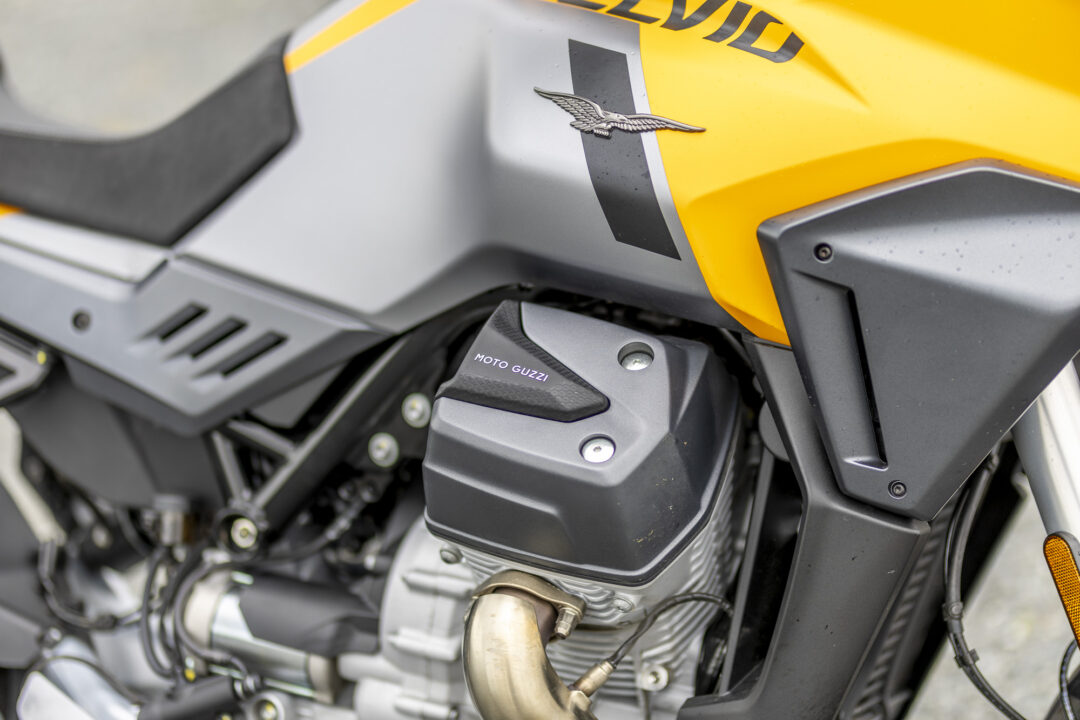
Does The New Engine Work In An Adventure Bike?
The ‘Compact Block’ powerplant is a bit of genius in that it has managed to achieve what Harley-Davidson has struggled with – producing a modern powerplant with the character/dynamics of the brand just without any of the quirks and idiosyncrasies that put a lot of riders off. H-D went water-cooled with the V-Rod and then seemingly gave up and returned to simply producing V-twins with ever-increasing capacities, just with a move to air/oil cooling rather than water.
Moto Guzzi has been much smarter with its new powerplant and has kept the same unique visual style of the transverse V-twin, yet has addressed all the issues that used to come with the old layout, making it thoroughly modern while also keeping its uniqueness.
Room for the rider was always an issue with the old twin, so the cylinder heads have been rotated, and the exhaust now exits below the cylinder, and the throttle bodies sit between the two pots, no longer encroaching into the rider’s leg space. It’s liquid-cooled, features DOHC valve gear and sports a gear-driven counterbalance that gets rid of the vibrations Guzzis used to rattle themselves to pieces with. And the capacity is smaller, the weight is significantly less, there’s all the modern lean-sensitive rider aids we expect nowadays, and while the output isn’t earth-shattering at 115hp, the way the new motor delivers its power has brought Moto Guzzi into the 21st Century. Suddenly, the Italian marque is a serious contender for any rider looking for a fast, comfortable motorcycle with modern conveniences and a bit of style.
The beauty of the 90º powerplant is that you get the low-down grunt that you’d expect from a 1042cc V-twin, with smooth and linear drive coming from as low as 2,800rpm which is shown on the modern 5-inch TFT dash. It’s typical Guzzi stuff as they always drove hard from low revs. But where the DOHC motor differs is that the power keeps going as the revs climb, with a significant hit as the needle passes the max torque point of 6,750rpm and continues to pull hard until you reach the max horsepower point of just under 9-grand. There’s not much use hanging on much after that, as the motor will drive much harder if you select another gear and drop back down the rev range slightly. But it’s certainly a Guzzi engine like no other, and I like it!
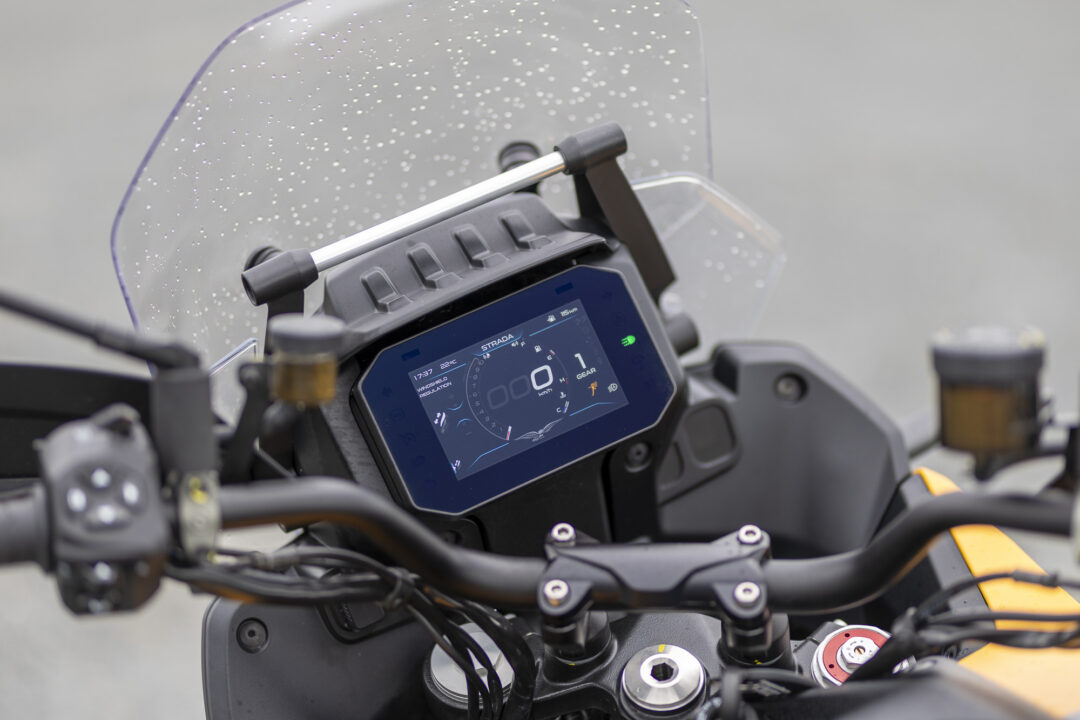
What Tech Does It Have?
With a ride-by-wire throttle, Moto Guzzi has been able to delve into the knowledge from Aprilia’s R&D centre to furnish the Stelvio with a comprehensive range of electronic aids, and they all work really well. Aprilia has some of the best and easiest to navigate electronics in motorcycling, and it’s great to see that Moto Guzzi has chosen to follow the same path.
The TFT dash is clear and concise, with a large central rev counter that comprises of the speedo in the middle while the gear indicator sits to the right. It’s all easy to see at a glance. A nice touch is the blind-spot radar fitted to our bike, which illuminates a light in the mirror if another vehicle is close to the rear of you. And there’s also the addition of an orange glow around the dash as another alert of someone encroaching on your space. Our test bike wasn’t fitted with the optional radar cruise control, but the black plastic square at the front and rear of the bike indicates where the system would sit if you did decide to go for it. And after using similar systems on other machines, I’d definitely tick the box if you do any sort of motorway or open road work, as it really does make the times you are travelling between the fun bits a whole heap easier.
Another option that wasn’t fitted to our bike was the quickshifter. And after using it on the V100 Mandello, this is definitely worth getting. While the gearbox on the Stelvio is good, it’s not what you’d call fast, with shifts not liking to be rushed. But fit the quickshifter and you can dance up and down the gearbox with ease, making the most of the characterful powerplant. It’s really good!
Switchable mapping is offered in five different modes, with the map displayed in Italian at the top of the screen – you can change it to English if desired. Maps include Off-road, Rain, Road, Tour and Sport, with throttle response, ABS and traction control settings changed in each map. Both Off-road and Sport turn the rear ABS off, while the traction control is also disabled in Off-road mode. And while you might not think that you’d need electronic aids on Moto Guzzis of old, you certainly do on the new ones, with the Stelvio more than happy to lift the front wheel or spin the rear when getting a bit heavy-handed with the throttle.
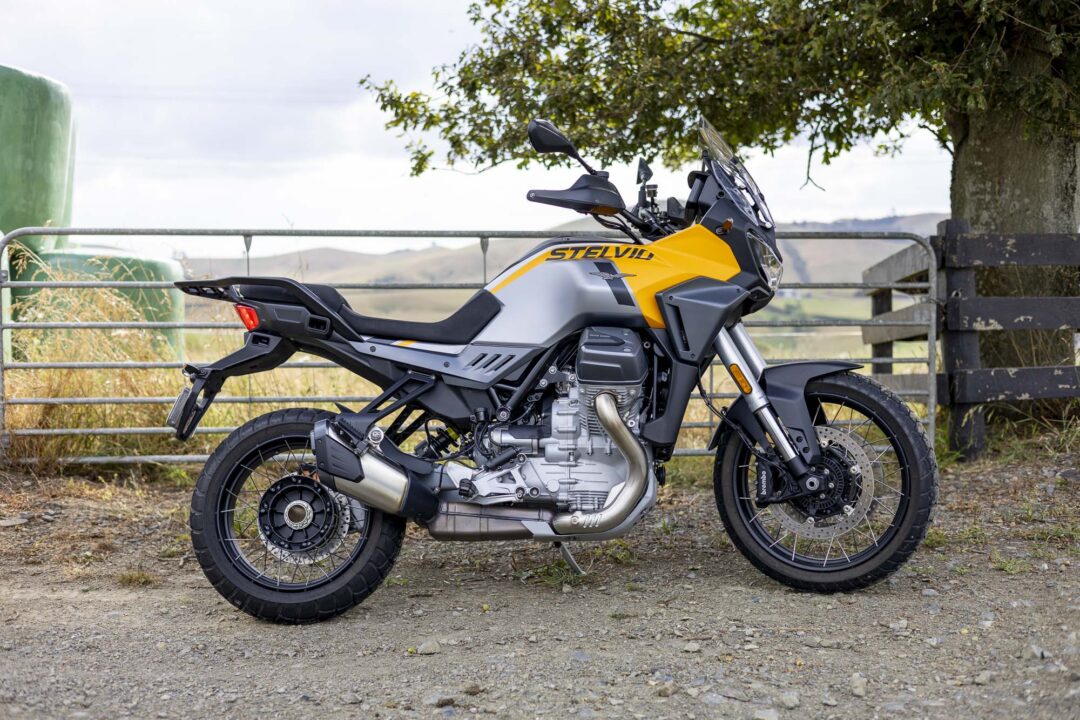
Can The Stelvio Go Off-Road?
While the Stelvio doesn’t have the tall, slim 21-inch front wheel favoured by adventure riders, it’s still more than capable of handling gravel and easy off-road riding. The Michelin Anakee tyres work exceptionally well on the road yet have also got enough chunk to them to give traction on loose surfaces. The spoked wheels look great, and with the spokes sitting outside of the tyre, it means the Michelins are also tubeless making for easier repairs at the side of the road should you pick something up in the tread.
Switching the electronics to Off-road gives the most aggressive power delivery while also disabling the traction control and rear ABS, making for plenty of sliding fun. Without any form of off-road traction control settings, you’re down to using the finesse of your throttle hand to stop getting carried away, but the flexible nature of the delivery means it never really feels like it wants to catch you out.
The Sachs suspension does a good job of handling the bumpy bits, with the 46mm fully-adjustable forks offering 170mm of travel and balancing road and off-road duties well. Certainly set to the firmer side, they don’t tend to dive too dramatically when making the most of the 4-piston Brembo monobloc calipers. The rear features a linkless rear monoshock with a remote preload adjuster that makes adjustment for luggage or a pillion as easy as turning the knob a few clicks. Again, it offers 170mm of travel, and while it’s not the sort of bike to be jumping rocks on, it’s certainly capable enough for handling the majority of dual-purpose duties.
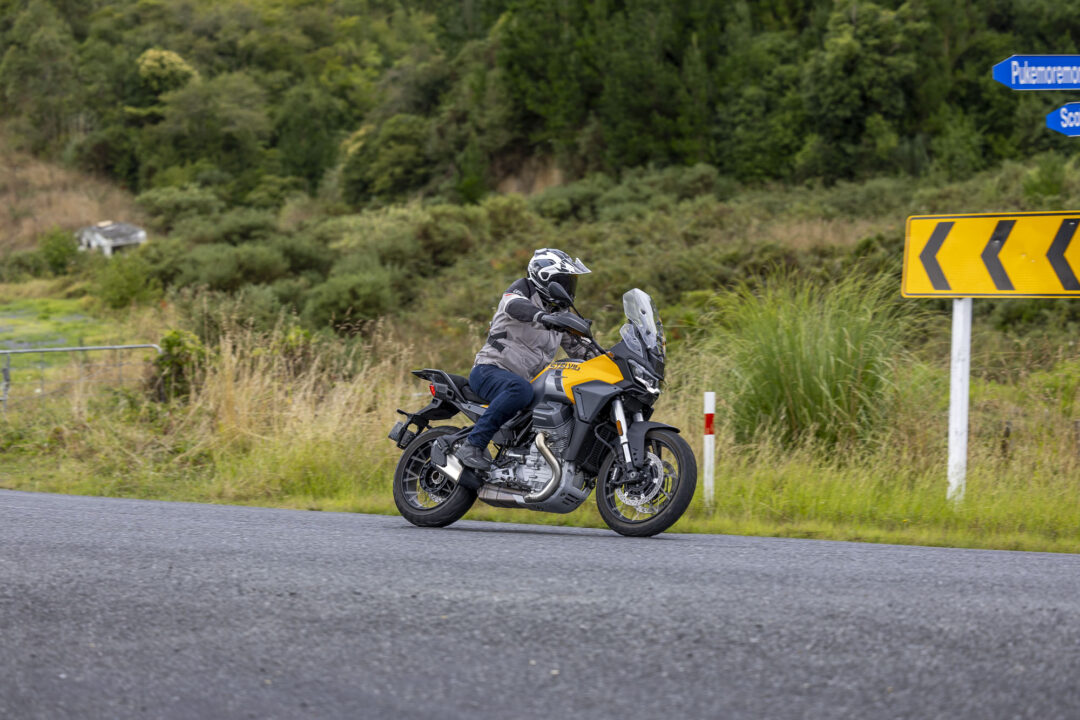
Verdict
I didn’t think I was going to like the Stelvio more than the Mandello (which was pretty much my fave bike of 2024), but in reality, the more relaxed riding position combined with such a sublime powerplant really won me over. And it’s seriously comfortable. I mean SERIOUSLY comfortable, with the rider and pillion saddles inviting enough for all-day riding. And fitting the factory luggage to the side is all it would take to make this an adventure tourer I would never want to stop adventuring on.
Yes, there are bikes with more power or lighter weight in the segment. And there are others that will be better on the dirt. But not many of them have the character and style of the Stelvio, which makes people stop and have a conversation with you when you park up for a coffee. Moto Guzzi has taken all the knowledge of the Piaggio group and used it to make a thoroughly modern and capable adventurer tourer, yet hasn’t lost the vision of their brand in the process. So, if you’re keen on a machine in this segment but want to stand out from the crowd, then make sure to check out your Moto Guzzi dealer when doing your homework.
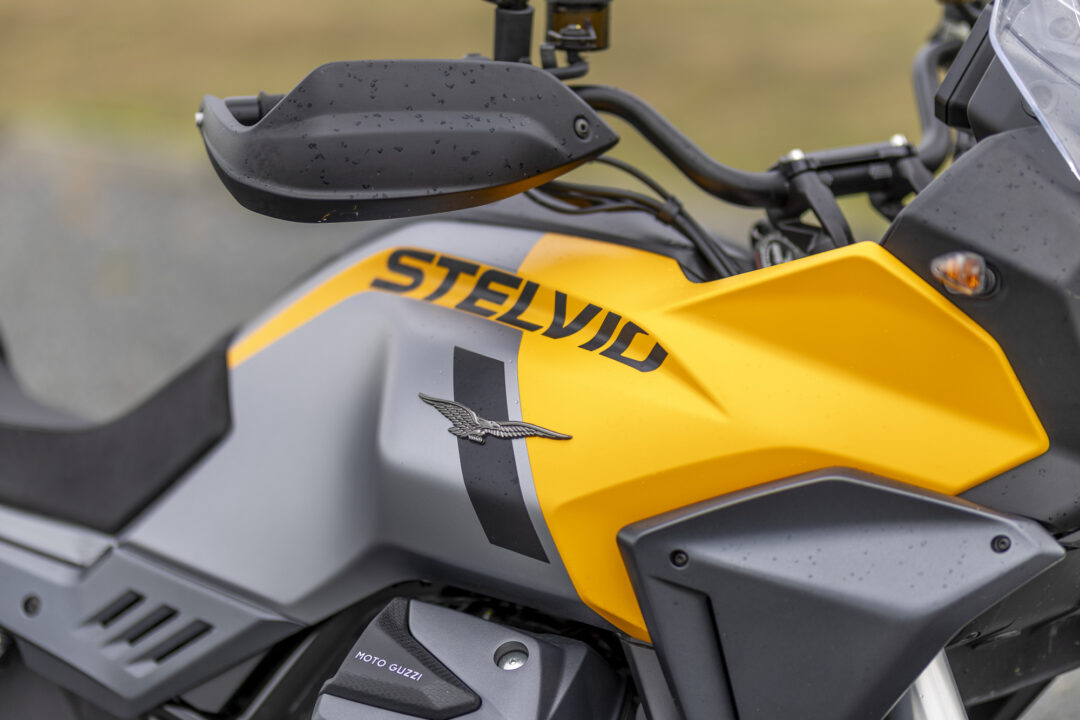
Specifications
Moto Guzzi Stelvio
Price: $31,490 + ORC
Engine:
• Type: Liquid-cooled 90° transverse V-twin cylinder, DOHC with finger rocker arms, four valves per cylinder
• Displacement: 1,042 cc
• Bore x Stroke: 96 x 72 mm
• Compression Ratio: 12.6:1
• Maximum Power: 115 hp (84.6 kW) at 8,700 rpm
• Maximum Torque: 105 Nm at 6,750 rpm
• Fuel System: Electronic fuel injection with dual Ø 52 mm throttle bodies and ride-by-wire management
• Fuel Tank Capacity: 21 litres (including 3.5 litres reserve)
• Fuel Consumption: 5.1 litres per 100 km (WMTC cycle)
Transmission:
• Clutch: Wet multi-disc with slipper function and hydraulic control
• Gearbox: 6-speed
• Final Drive: Cardan shaft with a gear ratio of 12/38 (3.166)
Chassis:
• Frame: Tubular high-strength steel
• Front Suspension: Sachs telescopic hydraulic upside-down fork, Ø 46 mm, adjustable for spring preload and rebound damping; 170 mm travel
• Rear Suspension: Aluminum single-sided shock absorber on the left side, adjustable for spring preload via knob and rebound damping; 170 mm travel
Brakes:
• Front: Dual stainless steel floating discs, Ø 320 mm, Brembo radial-mount calipers with 4 opposed pistons and metal braided hoses
• Rear: Stainless steel disc, Ø 280 mm, Brembo floating 2-piston caliper
• ABS: Continental system with cornering function
Wheels and Tyres:
• Front Wheel: Tubeless spoked, 3.0″ x 19″
• Rear Wheel: Tubeless spoked, 4.5″ x 17″
• Front Tyre: Radial tubeless 120/70 – R19
• Rear Tyre: Radial tubeless 170/60 – R17
Dimensions:
• Length: 2,195 mm
• Width: 945 mm
• Wheelbase: 1,520 mm
• Seat Height: 830 mm
• Steering Head Angle: 25.6°
• Trail: 116.4 mm
• Dry Weight: 222 kg
• Wet Weight: 246 kg (with all operating fluids and 90% fuel)
Electrical System:
• Generator: 550 W
• Battery: 12 V – 12 Ah
Additional Features:
• Riding Modes: Five modes (Touring, Rain, Road, Sport, Off-Road)
• Traction Control: Four levels (MGTC)
• Engine Brake Control: Three levels (MGFM)
• Cruise Control: Standard
• Lighting: Full LED system with cornering lights
• Instrument Panel: 5-inch color TFT display
Contact: www.motoguzzi.com

